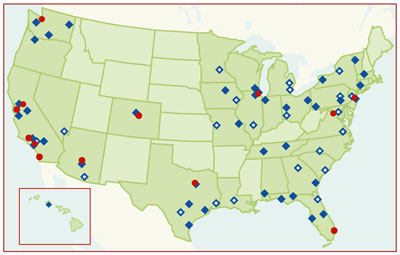|
|
Home | Services | Locations | Contact | About Us |
|
MoldReport™ Toll Free: 800.224.1527 Email: [email protected]
Mold Lab Locations
Information & Forms Chain of Custody (pdf) Buy Sampling Supplies (offsite) Log-in to LabServe™ (offsite)
For the Home Owner Real Estate News (offsite) Inspection News (offsite)
Mold Resources |
Mold AllergiesAlong with pollens from trees, grasses, and weeds, molds are an important cause of seasonal allergic rhinitis. People allergic to molds may have symptoms from spring to late fall. The mold season often peaks from July to late summer. Unlike pollens, molds may persist after the first killing frost. Some can grow at subfreezing temperatures, but most become dormant. Snow cover lowers the outdoor mold count dramatically but does not kill molds. After the spring thaw, molds thrive on the vegetation that has been killed by the winter cold. WHAT IS MOLD ALLERGY? In a small number of people, symptoms of mold allergy may be brought on or worsened by eating certain foods, such as cheeses, processed with fungi. Occasionally, mushrooms, dried fruits, and foods containing yeast, soy sauce, or vinegar will produce allergic symptoms. There is no known relationship, however, between a respiratory allergy to the mold Penicillium and an allergy to the drug penicillin, made from the mold. WHERE DO MOLDS GROW? WHICH MOLDS ARE ALLERGENIC? ARE MOLD COUNTS HELPFUL? In addition to the effect of day-to-day weather changes on mold counts, spore populations may also differ between day and night. Day favors dispersal by dry spore types and night favors wet spore types. ARE THERE OTHER MOLD-RELATED DISORDERS? In some individuals, exposure to these fungi also can lead to asthma or to a lung disease resembling severe inflammatory asthma called allergic bronchopulmonary aspergillosis. This latter condition, which occurs only in a minority of people with asthma, is characterized by wheezing, low-grade fever, and coughing up of brown-flecked masses or mucus plugs. Skin testing, blood tests, X-rays, and examination of the sputum for fungi can help establish the diagnosis. Corticosteroid drugs are usually effective in treating this reaction; immunotherapy (allergy shots) is not helpful. HOW DO I FIND A MOLD INSPECTOR? |
©2008 MoldReport™






